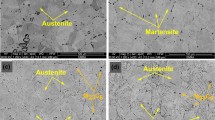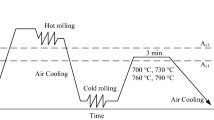Abstract
Commercial AISI 4340 ultrahigh strength steels with hot-rolling reductions of 80 to 98 pct have been studied to determine the effect of the shape of sulfide inclusions on plane-strain fracture toughness(K IC ) of the ultrahigh strength low alloy steels. The significant conclusions are as follows: decreasing the hot-rolling reduction from 98 to 80 pct for the steels modified the shape of sulfide inclusions from the stringer (average aspect ratio = 17.5) to the ellipse (average aspect ratio = 3.8). This improved theK IC in the longitudinal testing orientation by about 20 MPa · m1/2 at similar strength levels. This could be due to the fact that the ellipsed sulfide-inclusions separate from the matrix during plastic deformation, producing large voids. During testing these act to blunt and arrest cracks propagating across the specimen which would normally cause failure. The decrease in the hot-rolling reduction also developed theK IC in the transverse testing orientation by about 17 MPa · m1/2 at increased ductility and Charpy impact energy levels. This can be attributed to the fact that lamellate fracture, which occurs in a brittle manner along the interfaces of the sulfide-inclusion/matrix at the crack tip, is considerably suppressed by modifying the shape of the inclusions from the stringer to the ellipse.
Similar content being viewed by others
References
G. Y. Lai, W. E. Wood, R. A. Clark, V. F. Zackay, and E. R. Parker:Metall. Trans., 1974, vol. 5, pp. 1663–85.
W. E. Wood:Eng. Fract. Mech., 1975, vol. 7, pp. 219–34.
R. O. Ritchie, B. Francis, and W. L. Server:Metall. Trans. A, 1976, vol. 7A, pp. 831–38.
R. O. Ritchie and R. M. Horn:Metall. Trans. A, 1978, vol. 9A, pp. 331–41.
K. H. Khan and W. E. Wood:Metall. Trans. A, 1978, vol. 9A, pp. 889–92.
Y. Tomita:Metall. Trans. A, 1987, vol. 8A, pp. 1495–1501.
W. C. Leslie:Trans. Iron Steel Soc., 1983, vol. 2, pp. 1–24.
J. H. Tweed and J. F. Knott:Met. Sci., 1983, vol. 17, pp. 45–54.
D. E. McRobie and D. E. Knott:Mater. Sci. Technol., 1985, vol. 1, pp. 357–65.
G. R. Speich and W. A. Spitzig:Metall. Trans. A, 1982, vol. 13A, pp. 2239–58.
T. B. Cox and J. R. Low, Jr.:Metall. Trans., 1974, vol. 5, pp. 1457–70.
F. B. Pickering: “Toward Improved Ductility and Toughness”, Climax Molybdenum Development Company LTd., Japan, 1971, pp. 9–31.
Annual Book of ASTM Standards, American Society for Testing and Materials, ASTM Standards E23-72, Philadelphia, PA, 1972.
J. E. Hilliard and J. W. Cahn:Trans. AIME, 1961, vol. 221, pp. 344–52.
Y. Tomita and K. Okabayashi:Metall. Trans. A, 1986, vol. 17A, pp. 1203–09.
J. Durnin and K. A. Ridai:J. Iron and Steel Inst., 1968, vol. 206, pp. 60–67.
K. Okabayashi, Y. Tomita, and I. Kuroki:Tetsu-to-Hagané, 1976, vol. 62, pp. 662–69.
Y. Tomita:Metall. Trans. A, in press.
E. R. Parker and V. F. Zackay:Eng. Fract. Mech., 1975, vol. 7, pp. 371–75.
M. Sarikaya, B. G. Steinberg, and G. Thomas:Metall. Trans. A, 1982, vol. 13A, pp. 2227–37.
V. F. Zackay, E. S. Parker, and W. E. Wood:Proc. of 3rd Int. Conf. on Strength of Metals and Alloys, Inst. of Metals and the Iron and Steel Institute, London;The Microstructure and Design of Alloys, 1973, vol. 1, pp. 175–79.
J. McMahone and G. Thomas:Proc. of 3rd Int. Conf. on Strength of Metals and Alloys, Inst. of Metals and the Iron and Steel Institute, London;The Microstructure and Design of Alloys, 1973, vol. 1, pp. 180–84.
M. F. Carlson, B. V. Narasimha, and G. Thomas:Metall. Trans. A, 1979, vol. 10A, pp. 1273–84.
S. Lee, L. Majno, and R. J. Asaro:Metall. Trans. A, 1985, vol. 16A, pp. 1633–48.
C. T. Forward and A. J. Forty:Phil. Mag., 1965, vol. 11, pp. 1067–82.
A. Gilbert, J. L. Ratliff, and W. R. Warke:Trans. ASM, 1965, vol. 58, pp. 142–49.
T. J. Johnston, R. J. Stokes, and C. H. Li:Trans TMS-AIME, 1961, vol. 221, pp. 792–802.
A. S. Tetelman and C. A. Rau, Jr:Proc. of the Ist Int. Conf. on Fracture, Sendai, Japan, 1965, vol. B-I, pp. 691–709.
T. J. Baker, F. P. L. Kavishe, and J. Wilson:Mater. Sci. Technol., 1986, vol. 2, pp. 576–82.
Author information
Authors and Affiliations
Rights and permissions
About this article
Cite this article
Tomita, Y. Effect of hot-rolling reduction on shape of sulfide inclusions and fracture toughness of AISI 4340 ultrahigh strength steel. Metall Trans A 19, 1555–1561 (1988). https://doi.org/10.1007/BF02674029
Received:
Issue Date:
DOI: https://doi.org/10.1007/BF02674029




